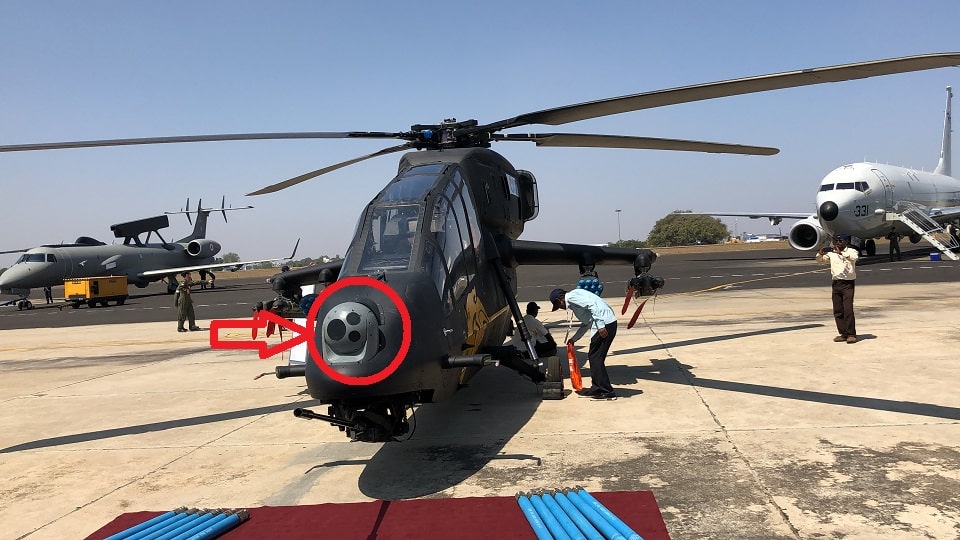Aerospace
How do the LCH and Dhruv Helicopter Surveillance Cameras function?
Have you ever wondered what type of camera is installed in the LCH helicopter and how it works?

This is the LCH and Dhruv Helicopter Surveillance Camera, which assists pilots in monitoring ground activity and providing other flying aid to aircraft.
The sensor enables the camera to give crisp imagery from severe darkness through the twilight transition phase. It is designed for a variety of nocturnal and extreme low-light imaging scenarios.
10 facts about the Light Combat Helicopter (LCH) made by Indian HAL. (Opens in a new browser tab)
It has a CCD camera, a forward-looking infrared imaging sensor, a laser rangefinder, and a laser designator to make target acquisition easier in all weather circumstances, including at night.
The camera was created exclusively for the Arrowhead Modernized Target Acquisition Designation Sight/Pilot on a Light Combat Helicopter.
IAF to induct first batch of domestically built LCH at Jodhpur (Opens in a new browser tab)
In the cockpits of most fighter jets and helicopters, there are many avionics gadgets that help the pilot make better decisions. Since this camera helps to resolute the display capability, it is tough to locate the landscape and the darker photos to achieve sharp focus in a warzone.
[adinserter block=”2″]
The LCA is a helicopter produced by Hindustan Aeronautics Limited, which also built the Dhruv Helicopter for the Indian Air Force. The majority of the technology is created by Bharath Electronic Limited in collaboration with a private company.
IAF to induct Made-in-India light combat helicopter at Jodhpur(Opens in a new browser tab)
The LCA is a high-altitude ground fighting helicopter that requires a sophisticated avionics system for surveillance. This camera will provide further benefits to the company’s operations. Please share your thoughts on the camera in the comments area.

Aerospace
Boeing Transfers Rocket Stage to NASA, Paving Way for Human Moon Mission

Boeing has achieved a significant milestone by providing NASA with the second core stage of the Space Launch System (SLS) rocket.
This crucial component, crafted at NASA’s Michoud Assembly Facility (MAF), is set to propel the Artemis II crew into lunar orbit, marking humanity’s return to deep space after a 50-year hiatus.
The monumental Boeing-built rocket stage, the largest element of the Artemis II mission, will embark on a journey aboard the Pegasus barge, traveling 900 miles to NASA’s Kennedy Space Center.
Comparison of two legendary aircraft B777x vs B747 aircraft:Click here
Upon arrival, it will be meticulously integrated with other essential Artemis II components, including the upper stage, solid rocket boosters, and NASA’s Orion spacecraft within the iconic Vehicle Assembly Building. This intricate integration process is a vital step toward the eagerly anticipated Artemis II launch, slated for 2025.
“Boeing-built products helped land humankind on the moon in 1969, and we’re proud to continue that legacy through the Artemis generation,” remarked Dave Dutcher, vice president and program manager for Boeing’s SLS program. “Together, with NASA and our industry partners and suppliers, we are building the world’s most capable rocket and paving the way to deep space through America’s rocket factory in New Orleans.”
NASA, Lockheed Martin Reveal X-59 Quiet Supersonic Aircraft:Click here
The delivery of Core Stage 2 marks a significant achievement in the evolution of the SLS rocket. Towering over 200 feet and powered by four RS-25 engines, this core stage, coupled with two solid-fueled booster rockets, will generate a staggering 8.8 million pounds of thrust. This immense power is crucial to launching Artemis II and future missions into the vast expanse of space.
The SLS rocket stands unparalleled in its capability to transport both crew and substantial cargo to the moon and beyond in a single launch. Its extraordinary capacity will facilitate the delivery of human-rated spacecraft, habitats, and scientific missions to destinations including the moon and Mars, ushering in a new era of space exploration.
-

 Travel1 week ago
Travel1 week agoAir India to Expand US Operations with Three New Routes After a Decade
-

 Travel2 weeks ago
Travel2 weeks agoWhy We Should Avoid These Stamps in a Passport
-

 Airlines1 month ago
Airlines1 month agoInvestigations Reveal Fake Chinese Titanium in Boeing and Airbus Jets
-

 Tech4 weeks ago
Tech4 weeks agoChina’s CATL Plans 1,800-Mile Electric Plane Launch by 2027
-

 Airport3 days ago
Airport3 days agoTop 10 Largest Airports in the World by Size
-

 Aerospace4 weeks ago
Aerospace4 weeks agoChina’s Fighter Jets Turn Wings into Autonomous Drones
-

 Airlines4 days ago
Airlines4 days agoAir India Rolls Out A350s for Delhi-New York JFK and Newark Routes
-

 Defence3 weeks ago
Defence3 weeks agoBoeing Enhances Chinook with New Engines and Block II Upgrades at $96 Million







